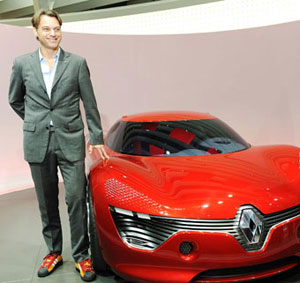
PARIS – Renault SA is preparing to end badge engineering of Dacia and Renault versions of the same car.
The change will help end confusion regarding what Renault now calls its “Entry” range, which includes vehicles based on the Logan platform sold under both brands.
The first step will be a new front end for Renault versions that features the wide “smiling” grille seen on the DeZir concept car exhibited at the Paris auto show last month.
One of the biggest challenges for chief designer Laurens van den Acker when he came to Renault from Mazda Motor Corp. a year ago was developing a design strategy for emerging markets.
“We created three steps of increasing differentiation,” he says in an interview with Ward’s.
Renault’s European lineup is priced too high for emerging markets, van den Acker says. However, rebadging a Dacia Logan as a Renault “gives us a price point for a new modern vehicle that allows us to sell and be in the sector.”
“In the beginning, it was important to enter these markets while they were growing to grab market share while it was there.”
| Model | Jan-Jun 2010 | Since 2004 | |
|---|---|---|---|
| Logan | 114,786 | 1,330,321 | |
| Logan MCV | 30,054 | 298,914 | |
| Logan Van | 6,216 | 28,053 | |
| Logan Pickup | 3,999 | 15,645 | |
| Sandero | 155,019 | 465,057 | |
| Duster | 14,813 | 4,813 | |
| Total | 324,887 | 2,152,803 | |
| Source: Renault SA | |||
Cross-badging, van den Acker notes, “is a short-term strategy not good for the long-term creation of a brand image, but you are entering markets where people are buying cars for the first time. So the notion of brand is not yet established.”
The second stage, he says, is to put a Renault front end on shared vehicles to differentiate them visually from Dacias.

“We will still use the base of the Dacia, but we will start to change the hood, the bumpers, the grille and the headlights,” van den Acker says. “The results of that are very promising. That allows us to get closer to the Renault image.”
If there is a business case for it, “I would like to go to a ‘top-hat’ solution, where you use the fundamentals of the base of the Dacia, which gives us the price point that we need,” he says. “Then we put a top hat on it that allows us to link the global image of Renault.”
Renault sells Logan-based cars as Dacias in Romania and other countries and as Renaults in emerging markets such as Brazil, Russia and Iran.
In 2005, 6.8% of vehicles in the Entry range were badged Renaults. In 2009, the figure grew to 41.8% of the 534,689 units sold. Renault versions in the first half of this year accounted for 44.8% of the growing total.
The conflict for van den Acker is that the external design of the Dacia brand is supposed to reflect “simple, generous and robust,” while the words guiding Renault’s design are “simple, sensual and warm.”
“Dacia is going to remain Dacia,” he writes in an online chat on the subject. “We have a brand with a great potential. We must separate the two brands. I have no wish to mix them together.”
Dacia’s design likely will move away from the boxiness of the current Logan, van den Acker writes.
“I think that you have already seen the evolution in Dacia's design with the launch of Duster at the start of the year. I find the design very surprising.
“It’s very attractive and hasn't lost any of its values of simplicity, generosity and robustness. The new Dacia Logan will be more inspired by the Duster than the former Logan model.”
Dacia is unlikely to produce a car much smaller than the Logan or Sandero, as providing a vehicle with more space at a lower price is a key part of Dacia’s market position. By the same reasoning, an electric Dacia is not planned.
The idea is “feasible, yes, but affordable, not so sure,” van den Acker writes in the Web chat. “For Dacia, it is important to remain affordable.”




